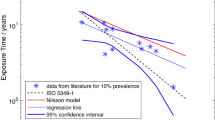Abstract
The complex of vascular, neurologic, and osteoarticular disorders occurring in the upper limbs of vibration-exposed workers is called hand-arm vibration syndrome. There is epidemiologic evidence for an increased occurrence of peripheral sensorineural disorders in occupational groups working with vibrating tools. An excess risk for wrist osteoarthrosis and for elbow arthrosis and osteophytosis has been reported in workers exposed to shocks and low-frequency vibration of high magnitude from percussive tools. However, there are too few epidemiology data to enable reliable conclusions to be drawn about exposure-response relationships for both sensorineural disturbances and bone and joint disorders caused by hand-transmitted vibration. Cross-sectional and longitudinal epidemiology studies have shown that occupational exposure to hand-transmitted vibration from a great variety of hand-held tools is significantly associated with an increased occurrence of digital vasospastic disorders called vibration-induced white finger (VWF). The proposal of an exposure-response relationship for VWF has been included in an annex to the international standard ISO 5349. The findings of several epidemiology studies have shown a poor agreement between the risk for VWF observed in various occupational groups and that predicted by the ISO 5349 model. Both overestimation and underestimation of the occurrence of VWF have been reported by investigators. It has been argued that the current ISO frequency-weighting curve for hand-transmitted vibration may be inappropriate for the assessment of vibration-induced adverse vascular effects. Alternative exposure-response relationships for VWF have been suggested in recent epidemiology studies. The epidemiology data used to construct current exposure-response relationships for vibration-induced injuries are primarily derived from cross-sectional studies. Future epidemiology research should be based on prospective cohort studies because the design characteristics of such studies permit the study of cause-effect relationships and the formulation of etiologic hypotheses.
Similar content being viewed by others
Author information
Authors and Affiliations
Additional information
Received: 16 March 1998 / Accepted: 6 July 1998
Rights and permissions
About this article
Cite this article
Bovenzi, M. Exposure-response relationship in the hand-arm vibration syndrome: an overview of current epidemiology research. Int Arch Occup Environ Health 71, 509–519 (1998). https://doi.org/10.1007/s004200050316
Issue Date:
DOI: https://doi.org/10.1007/s004200050316




